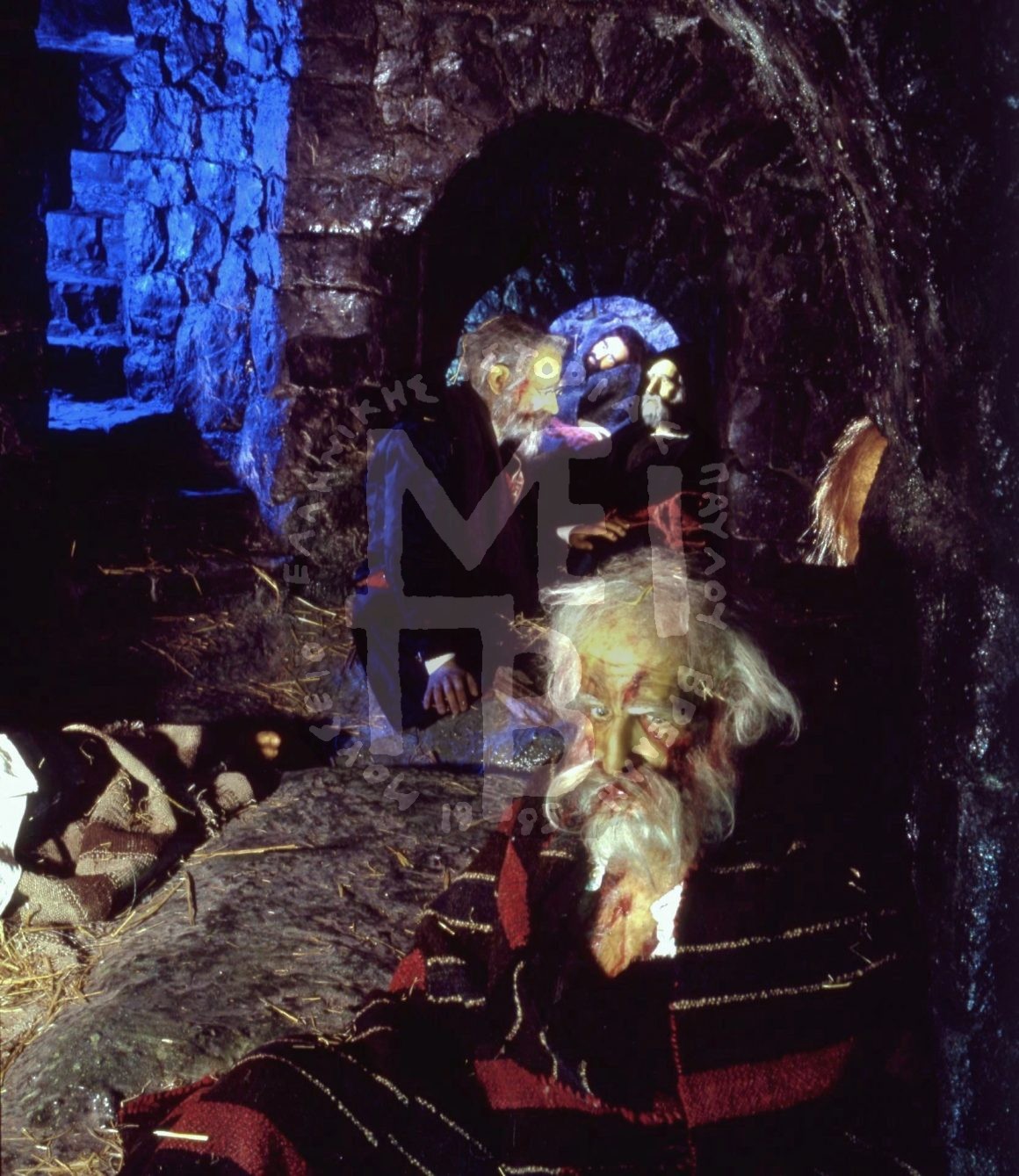“There were lots of prisons during the Turkish rule. They were aimed to imprison the Hellenic soul that fought against the conqueror in its way. They were a place in which the spirit and the dream of each Greek slave (ragias) that longed for freedom was imprisoned.
People were put in them either after a battle defeat, or as a result of ambushes or unsuccessful missions, or even because of talks they had about freedom. They rot in jail with no sun, water or food, sick with no treatment whatsoever. Some lived a few hours, months or years, while others until they passed away.
Right after Katsadonis composition, on the left, we pass through a stone arch near rocks that sustain part of the arched corridor. The rock and wall succession indicates the location of the prisons. I found it difficult to work this entire site – the interior of the room and the corridors. I stuck those thousands of stones on the brick wall with cement. I painted them accordingly, so as to create a damp, moldy and depressing atmosphere.
We receive the first information from a small window with thick railings. Through this, the visitor can see the small and cramped room of the jail by means of seven plans. It starts with a crossed arch and ends at a wall background. I chose the crossed arch first as a form that puts aesthetic pressure, thus conveying the prison atmosphere. Several little and larger arches, windows, ladders, niches, ellipsoid arches and so on are being developed gradually. In this way, I create rooms that portray by themselves the oppression they exert.
With the arches I juxtapose one after the other (starting from the tallest near the visitor) I guide their eye. The prisoner we see in the foreground is very close to the visitor. The one in the background is behind the stairs you will later climb to reach Kouggi.
Moving on along the corridor, on your right, there is a door with studs. This is one of the emergency exits, but it is also a functional element of the prisons. Turning on your left, a long corridor appears, at the end of which we see Rigas Ferreos’ prison. I create a long axis and I make the visitor stop in the middle of it. Through a large opening with thick iron railings, they can see the entire composition of the prison. So that the visitors can feel the depth, I create little openings up on the arch and on the corridor wall.
Above the prison room, arched and supported on pillars, I made ‘Kouggi’ and above that, the ‘Asia Minor’ theme.
I visited as many prisons of the time of Turkish rule as I could, all over Greece. Tears filled my eyes as drops of dampness dripped over me. I felt their pain, I came to know their secrets and I admired their endurance in time. I bent the knee before each and every one of them, praying silently for the souls that were lost.
During the German Occupation, I was imprisoned –young at the time– in Zosimea Academy and in St Kosmas’ prison in Ioannina. During that time, I realized what it means to be in jail, imprisoned, moribund but also what freedom means. For this reason, from the prisons I saw photographed and lived in, I made one, of my own design and composition; a prison that narrates and bring into memory all the pre-revolution prisons. I placed inside them all those people who fought the tyrant: young and old, educated and common people. I tried to give characters of people of varied mental conditions to the figures I placed, and positions according to their psyche and personality.
The figures portray pain, both mental and physical, indignation, hatred, forbearance, ultimate pain, suppressed anger, decay, vengeance and courage.
[Looking through the small window…]
In the foreground, a common man is sitting covered, filled with bitterness. On the left, towards the wall, leaning in the corner and covered in his worn cape, sick and in pain, is secretly seeking revenge. In the background, one of the old prisoners, who hasn’t seen the sunlight for years, is lying down pale and withered. He is trying to reach the moldy, gnawed by mice bread with his right hand. (I made the bread in my workplace with bulged polyurethane.
[Looking through the large arch…]
Near the visitor is a young man, wounded on his head and body expressing his physical and emotional pain. The old man at the back, an old klepht on the mountains, heavily wounded, shows his resentment while bearing the burden of the pain and of his old age with difficulty. Near the stairs, the intellectual thinker with the glasses is trying to place himself in the place with endurance. In the background, behind the stairs door, the head only of one of the soldiers appears through the small window. On the other side at the back, under the big and small niches a well built, courageous klepht is trying to assist the heavily wounded old armatolos, who painstakingly can control his rage and indignation. At the back of the prisons, on the left, a priest is patiently sitting with courage and faith, touching the imprisoned patriot who is dying in great pain.
I lived in anxiety wile working for months to finish. I leave all visitors free to disclose this enclosed place, in the years of pre-evolution, called Prison.”

